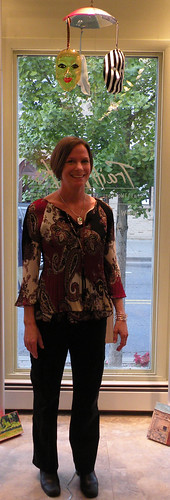admission by donation,
proceeds to benefit Birth Haven
Pass the tissues! This coming Saturday, TraillWorks will be hosting a screening of the film, Who Does She Think She Is? by Academy Award winning director, Pamela Tanner Boll. I saw this film with artist, Martha C. Hall, earlier this year at the Morris Museum and knew that I had to share it with you at my gallery. I bought the DVD from Amazon within the week and starting planning this screening.
The documentary film follows five female artists who are all mothers and examines the pressures of following their passions and careers while balancing their individual family lives. When I discovered this film almost a year ago, prior to seeing it, I had already had my son, Joel, and was furiously juggling caring for him, running a household, running an art business, and making my own work. I found this film to be profoundly inspiring both spiritually and artistically, as well as an amazing stimulus of passion.
 |
| Joann Wells Greenbaum with her "Lady of the House |
 |
| Jennie Traill Schaeffer ©Alex Cena |
 |
| Amy S. Brooks with her Stained Glass Mobile |
Amy S. Brooks is the owner of Paradise Stained Glass of Metuchen, NJ and is the mother of two teenage sons. Joann Wells Greenbaum, now an empty-nester, is a successful independent artist from Shohola, PA, a mother of two grown sons. And I am entering motherhood on the other end with an almost three-year old son. I am a painter who owns TraillWorks - my studio and gallery.
This screening marks the end of a two-month long exhibit of women's art
in our 1st Annual Women's Invitational Exhibit which featured 13 women
who interpreted the play, "Hope Throws her Heart Away" by playwright
Susan Goodell. We hosted a play reading in September performed by Tri-State Actors Theater;
the artists' reception was held last Saturday and this will bookend the
exhibit on Saturday. The exhibit runs through November 5th. To learn
more about the exhibit and its artists, click here. View an album of photos from the exhibit reception here.
Admission to the film is by donation. All donations will be going to support Birth Haven, a local 501(c)3 that provides shelter and hope to young pregnant mothers. Just before the film starts, the director of Birth Haven will present a brief overview video of the opportunities and love that the organization provides to its residents. I felt this was a fitting charity to extend support to given the hard choices that both the artists in the film and the residents of Birth Haven have to make to pursue a better life.











